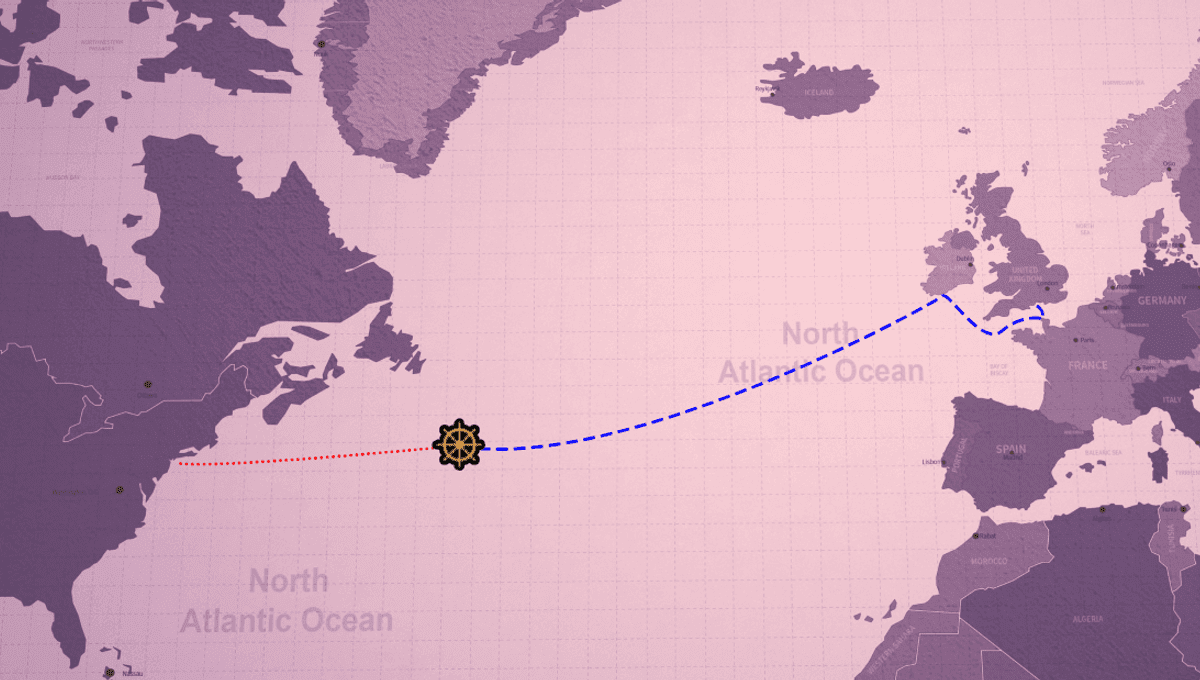
On April 15, 1912, an iceberg sank an “unsinkable” ship. The Titanic was the largest ocean liner in the world when it set sail on its maiden voyage from Southampton, UK, to New York, USA. However, its short career would come to a devastating end four days into crossing the Atlantic, claiming the lives of over 1,500 people.
The doomed vessel has been at the forefront of minds across the globe recently following reports of OceanGate’s Titan submersible that went missing while visiting the famous shipwreck. The harrowing situation has stirred up a century-old story, leading to many realizing that the Titanic didn’t sink anywhere near where they’d imagined.
The Titanic’s journey from Southampton to New York kicked off with a short leg across the English Channel to Cherbourg, France, and onto Queenstown, Ireland, which is now known as Cork’s port, Cobh. From here, it was near enough straight across the Atlantic to reach New York. Unfortunately, four days and over 3,200 kilometers (2,000 miles), disaster struck. To be specific, an iceberg 640 kilometers (400 miles) off Newfoundland, an easterly province of Canada.
Records say that of the 2,201 passengers on board, 1,489 fell into the water and all of those were recorded as having drowned. However, the primary cause of death was suggested to instead have been immersion hypothermia in a 2003 paper, as people froze to death from being submerged in water that was -2.2°C (28°F).
The deadly freeze and giant pieces of ice apparently led many to believe that the Titanic was a lot further from America when it sank, as recent maps demonstrating the ship’s final resting place have taken a lot of people by surprise.
Another realization that’s shocked many following the recent disaster of the lost OceanGate submersible is the staggering depth at which the Titanic wreck sits in several pieces. Laying on the ocean floor, they’re around 3,810 meters (12,500 feet) from the ocean’s surface and the two major pieces sit 790 meters (2,600 feet) apart, reports CBS News.
A harrowing visual doing the rounds on Twitter goes some way to demonstrating quite how vast a depth that is.
The search for the missing OceanGate submersible continues, but as Professor Sam Drake, co-Director of the Centre for Defence Engineering Research and Training at Flinders University, explained in a statement, localizing Titan is a uniquely difficult task.
“Sonar relies on sound waves being sent and the ‘echo’ of the vessel being heard sometime later. The time delay between the return of the sound wave tells us how far away the vessel is. Using a bunch of sonar receivers, we can determine the location of the object that the signals bounce off. The problem is we must be close enough to ‘hear’ the echo and we have to be able to distinguish the echo of Titan from marine life and other objects, such as shipping containers.”
“If Titan is sending out any signals we can try can detect them and locate the emitters and hence the vessel. This is called passive localisation. If Titan is making noise, either by a propeller or people talking it may be possible to pick up the sound and locate the vessel in the same way that sonar works without the need to send out a signal.”
“This is a needle in a haystack situation but by combing, visual observations, radar, sonar, and passive techniques hopefully Titan will be found soon.”
Source Link: Many People Are Only Just Finding Out Where The Titanic Actually Sank